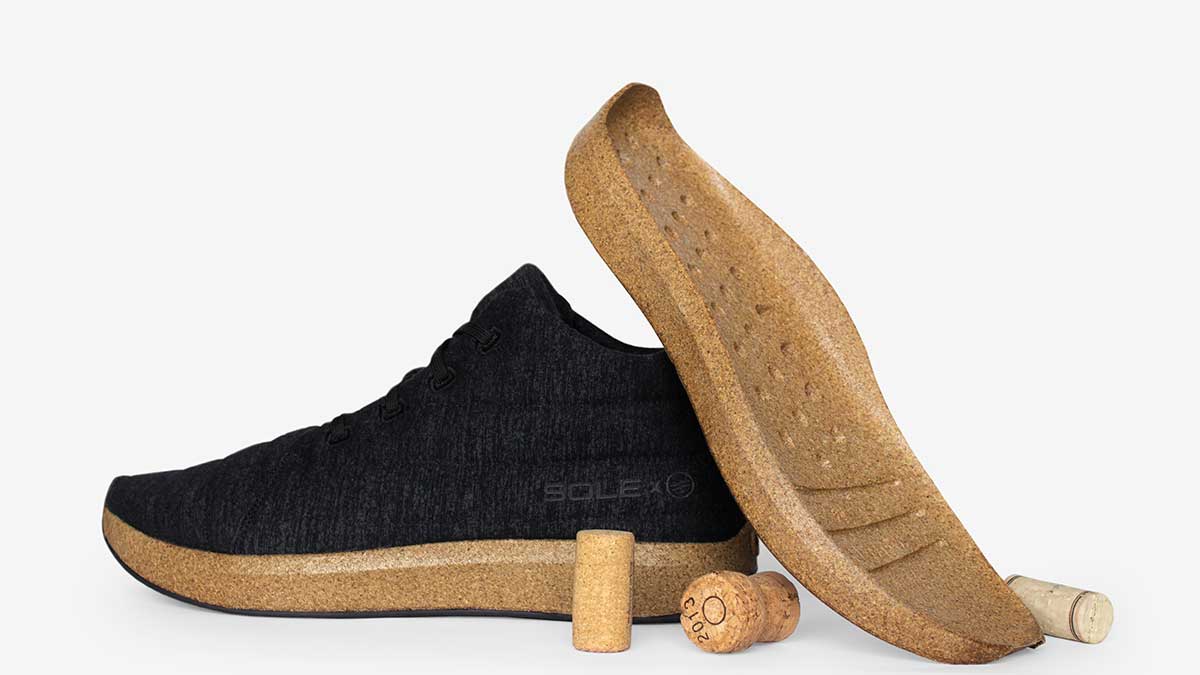
Most people recognize that wine corks are special. You pop them from the bottle, and that small cylinder of natural material seems too good to toss in the trash. But you can recycle cork, and a new cork recycling program, ReCORK accepts corks through a network of public collection partners across North America.
ReCORK turns corks into a remarkable new material developed through years of research and development: ReCORK Recycled Cork. This material bends, flexes and cushions just like a synthetic foam, but with a tiny fraction of the environmental impact of the foams we see so often that are made from petrochemicals. You can find the nearest ReCORK location to you by visiting recork.com/locations
Inspired by a 75 year old natural cork floor.
ReCORK was founded in 2008 by footwear company SOLE, which has been making aftermarket insoles for shoes since they launched in 2001. The company was founded to offer customers pain relief and injury prevention through an affordable alternative to prescription orthotics. In the mid 2000’s, founder Mike Baker became determined to ensure that the brand had a positive impact not just on the lives of their customers, but on the planet too.
It was during this time that Baker spent a weekend away at a beachfront cottage with family friends. Over the weekend he was inspired by the cork floor of the cottage. It felt great underfoot, insulated against the cold, and was in remarkable condition, 75 years after the cottage had been built. Baker started looking into cork with more interest, and what he learned inspired him even further.
The incredible sustainability of natural cork.
Cork is harvested from the bark of cork oak trees, every 9 to 12 years without ever cutting a tree down. Harvesting the bark regularly actually extends the lifespan of the tree from around 75 years to more than 200 years. The harvest also stimulates the tree to increase its carbon consumption by up to 5X (source).
Cork trees are harvested by hand in a skilled trade passed down over generations. These cork farmers grow and safeguard the trees, which in turn provides crucial habitat for numerous endangered species. The cork industry is a fantastic example of traditional sustainable land use.
Having learned this about cork, Baker and the SOLE team became determined to utilize this incredible material in their footwear products. They launched ReCORK to collect and recycle used natural wine corks, extending the useful life of a valuable material that was going to waste. In the years since, ReCORK has collected more than 132 million corks for recycling.
Recycled cork in footwear and beyond.
The footwear industry accounts for 700,000,000 kilograms of greenhouse gas emissions per year, making up 1.4% of all global climate impacts. A large portion of this is thanks to carbon-intensive fossil fuel-based foams in the midsoles of so many sneakers. Cork can replace that foam and has many characteristics aside from sustainability that make it perfect for use in SOLE’s orthopedic insoles and footwear. It’s naturally lightweight, insulating, antimicrobial, rot-resistant and shock-absorbing.
Using cork in footwear isn’t new. There’s an established precedent for creating cork composite materials that increase durability to an extent. These materials traditionally use ground cork among synthetic binders and flexing agents like latex. For the most part, they will use relatively small proportions of cork (often far less than 50%). ReCORK Recycled Cork is overwhelmingly still cork: more than 75%.
SOLE uses recycled cork in lines of insoles and sandals, but for all its strengths, natural cork has one major limitation: it is brittle, snapping under stress. Footwear naturally undergoes a lot of dynamic forces, making the brittleness of cork a serious obstacle to its possible applications. To truly unlock cork’s potential for use in footwear, this brittleness needed to be overcome. They also degrade when exposed to water regularly.
It was this need that led the ReCORK R&D team to innovate a completely new way of working with cork. Their recycling process grinds down the cork and recombines it using a patented technique to create a unique new material. ReCORK Recycled Cork bends, flexes and rebounds. It’s lightweight and cushioning. It offers all the functional strengths of synthetic foams like PU and EVA. It’s also impervious to water.
The material made its debut earlier this year in SOLE’s latest offering, the Jasper Chukka. While footwear has been the initial focus, the possible applications for ReCORK Recycled Cork are almost limitless. ReCORK hopes to maximize their positive impact by replacing synthetic foams in consumer products across various industries.
Recycle corks to help ReCORK set a new standard for sustainable materials.
Find your local cork drop-off point and bring them your natural corks! No drop-off points in your community? Any organization can sign up to be a Public Collection Partner, collecting corks and shipping them to ReCORK. Suggest to your local liquor store or grocer that they sign up, or sign up your office building.
You can also suggest to your local bar or restaurant that they sign up to be a Private Collection Partner. These partners don’t collect from the public, but send ReCORK the natural corks they use during their regular business.
About the Author
Paul Maughan-Brown is the words guy, the press releases and product descriptions guy, the blog posts and banner-mantras guy at SOLE.
- SEO Powered Content & PR Distribution. Get Amplified Today.
- PlatoData.Network Vertical Generative Ai. Empower Yourself. Access Here.
- PlatoAiStream. Web3 Intelligence. Knowledge Amplified. Access Here.
- PlatoESG. Carbon, CleanTech, Energy, Environment, Solar, Waste Management. Access Here.
- PlatoHealth. Biotech and Clinical Trials Intelligence. Access Here.
- Source: https://earth911.com/how-to-recycle/guest-opinion-recycle-cork-to-replace-petroleum-based-polymers-and-foams/
